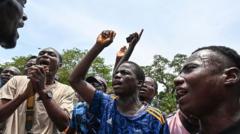As Vietnam celebrates 50 years since the war's end, the younger generations embrace rapid changes and new opportunities.
Vietnam's Youth: Building a New Future Post-War

Vietnam's Youth: Building a New Future Post-War
A look into Vietnam's transformation and the aspirations of its young population.
As Vietnam commemorates the 50th anniversary of the end of the Vietnam War, a striking transformation unfolds. The vast majority of the nation's 100 million citizens—born since the fighting ceased—experience a vibrant society that has emerged from the ashes of conflict. Over the decades, poverty has significantly decreased, ushering in an era of globalization that presents both challenges and opportunities.
Today's Vietnam is characterized by a youthful, ambitious spirit eager to carve out new paths. Amidst this promising backdrop, one question lingers: what role does the war play in the lives of this new generation?
Reflecting on the past, Vu Dang Toan, who famously commanded the first tank into Saigon’s Independence Palace in 1975, shares his journey. From a soldier witnessing the war's horrors to a retiree in comfortable surroundings, he now observes the world through his grandson’s eyes. Dang Hoang Anh, 14, embodies a generational shift, expressing aspirations of studying abroad and securing financial success—far removed from the burdens faced by his grandparents.
Meanwhile, the promise of prosperity brought by globalization has its pitfalls. Vietnam's economy favors large foreign and state-backed enterprises, intensifying inequalities. As some thrive, grievances regarding social inequities and environmental concerns rise among those left behind by progress.
Young people in Vietnam, navigating a complex landscape of modernity and tradition, often find themselves seeking solace in both social media and spiritual communities. The revival of interest in traditional religions underscores their quest for stability amid rapid change—a modern counterpart to Karl Marx's observation of religion as the "opiate of the masses."
As the country moves forward, the present generation expresses a desire not just to earn but to define their identity within an evolving Vietnam. Outside key urban areas, industrial developments juxtapose the historical scars of warfare, demonstrating a commitment to progress without the comforts of suburban familiarity or the order found in other countries.
In this climate of hope and uncertainty, today's youth are poised to craft a new narrative for Vietnam—one shaped by hard work, ambition, and an enduring connection to their heritage.
Today's Vietnam is characterized by a youthful, ambitious spirit eager to carve out new paths. Amidst this promising backdrop, one question lingers: what role does the war play in the lives of this new generation?
Reflecting on the past, Vu Dang Toan, who famously commanded the first tank into Saigon’s Independence Palace in 1975, shares his journey. From a soldier witnessing the war's horrors to a retiree in comfortable surroundings, he now observes the world through his grandson’s eyes. Dang Hoang Anh, 14, embodies a generational shift, expressing aspirations of studying abroad and securing financial success—far removed from the burdens faced by his grandparents.
Meanwhile, the promise of prosperity brought by globalization has its pitfalls. Vietnam's economy favors large foreign and state-backed enterprises, intensifying inequalities. As some thrive, grievances regarding social inequities and environmental concerns rise among those left behind by progress.
Young people in Vietnam, navigating a complex landscape of modernity and tradition, often find themselves seeking solace in both social media and spiritual communities. The revival of interest in traditional religions underscores their quest for stability amid rapid change—a modern counterpart to Karl Marx's observation of religion as the "opiate of the masses."
As the country moves forward, the present generation expresses a desire not just to earn but to define their identity within an evolving Vietnam. Outside key urban areas, industrial developments juxtapose the historical scars of warfare, demonstrating a commitment to progress without the comforts of suburban familiarity or the order found in other countries.
In this climate of hope and uncertainty, today's youth are poised to craft a new narrative for Vietnam—one shaped by hard work, ambition, and an enduring connection to their heritage.



















